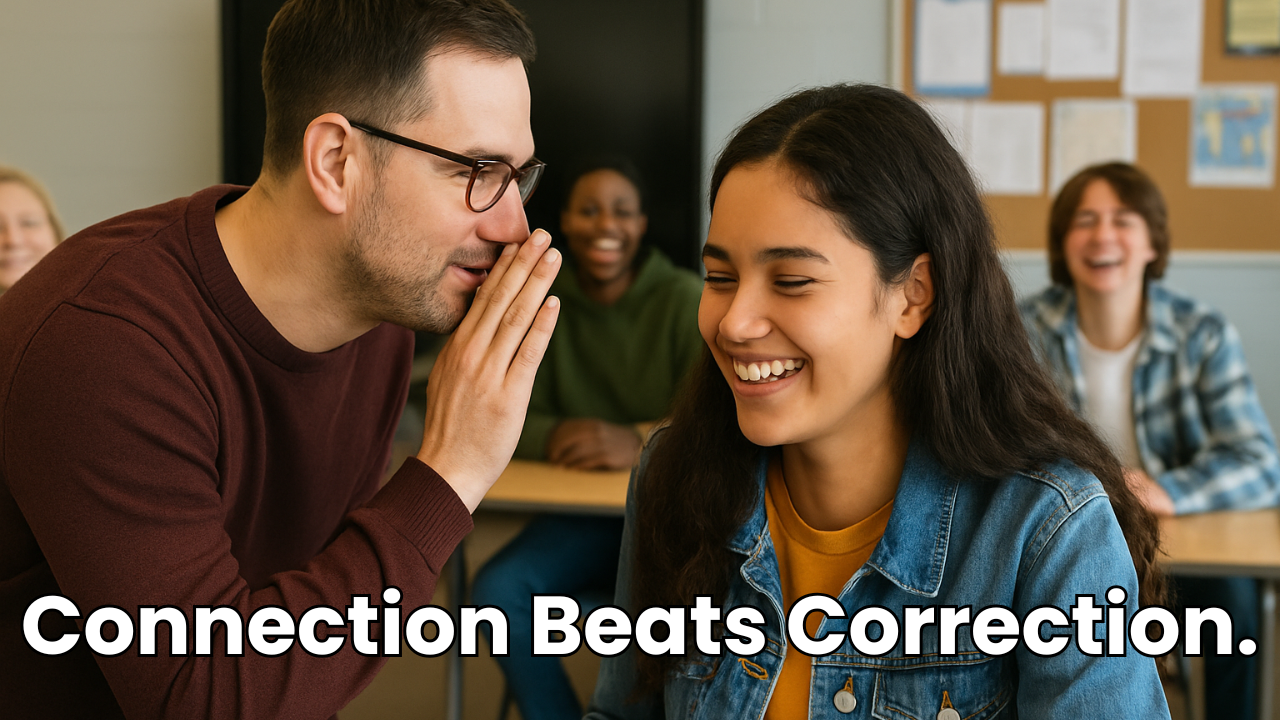
As language teachers, we play a crucial role in helping our students acquire the target language effectively.
One of the most powerful techniques we can employ is providing comprehensible input.
By ensuring that our students can understand the language we use, we create an environment where acquisition can thrive.
In this blog post, I want to share my top 10 tips for providing great comprehensible input.
So, let's dive right in!
1. Go Slowly
When it comes to delivering lessons, we have to find that sweet spot of pacing that allows all our students to keep up with the journey.
Slow down and let your words flow like a lazy river, taking the time to speak clearly and with intention. Your students need to comprehend what you're saying, and that requires a steady pace that gives them the opportunity to absorb the language.
In our fast-paced world, it's easy to get caught up in the rush, but when it comes to teaching, it's time to hit the brakes.
Take a deep breath and embrace the art of explanation. Break down complex concepts into bite-sized pieces, and be there for your students every step of the way.
Provide examples that bring the language to life, painting vivid pictures in their minds. And don't forget to leave some space for their thoughts to wander and process the information. Your students need time to digest the language and make it their own.
Yes, we want to cover all the important content, but rushing through a lesson like a runaway train isn't going to do any good.
It's far better to slow down, check in with every student, and make sure everyone is on board.
Let's prioritize their understanding and growth over blindly following the strict curriculum pacing guide.
After all, the true success of our teaching lies in the progress and comprehension of our students, not in ticking off boxes on a predetermined timeline.
So let's take a deep breath, find our pace, and create a learning journey where no one gets left behind!
2. Write New Words on Board
As you’re teaching new words, don't forget to write them down on the board alongside their translations. It's like creating a colorful vocabulary roadmap for your students to follow.
Now, here's a little trick to take it up a notch: use different colors for the target language and the translation.
It's like painting a picture of clarity on the board.
Your students will instantly know which language is which, and it will add that extra touch of visual distinction.
At the beginning of the school year, get ready for a burst of vibrant vocabulary explosion on that board of yours.
But as the year progresses and your students become more skilled in the language, you can gradually reduce the number of words on the board.
Instead, focus on building upon the vocabulary they have already learned.
These visual aids will serve as helpful reminders and references for your students.
They'll navigate the intricacies of the language with confidence, glancing at the board whenever they need a refresher.
Pro tip: Create a two-column table in a Google Doc and write your words there. That way, you have a record of what you wrote and can share it with students.
These visual aids will serve as helpful reminders and references for your students as they navigate the intricacies of the language.
3. Solid Base
Building a solid base of high-frequency verbs is like laying a strong foundation upon which you can build throughout the year, brick by brick.
I highly recommend Mike Peto's Sweet 16. It’s a solid foundation that I build my curriculum upon.
Now, let me introduce you to these impactful 16 verbs:
- there is
- is
- is located/is feeling
- wants
- has
- goes
- likes
- puts
- says
- gives
- leaves
- can/is able to
- knows (a fact)
- does/makes
- sees
- goes back/returns
These verbs, carefully selected by Mike Peto, form the backbone of functional language. They are the MVPs of everyday communication.
By focusing on this small set of commonly used verbs, you provide your students with a solid foundation.
Here's the beauty of it: these verbs become the building blocks for more complex language structures.
Your students will start with these verbs, gaining confidence in using them to express a wide range of ideas.
It's like they're equipped with a powerful toolkit, enabling them to communicate effectively in various situations.
And here's the real kicker: by emphasizing these few verbs, you actually end up teaching more effectively.
Instead of overwhelming your students with a never-ending list of vocabulary, you're giving them the essential tools they need to navigate the language landscape.
They'll grasp the core concepts more deeply, allowing them to naturally expand their language skills as they progress.
Your students will gain confidence in using these verbs, and from there, they can expand their language skills naturally.
4. Gestures
Teaching vocabulary through gestures is an effective method for learners of all ages and proficiency levels.
Whether you’re working with young children or adult learners, incorporating gestures makes the language learning experience more engaging and memorable.
Assigning gestures to your core vocabulary not only adds a fun and interactive element to your lessons but also engages the muscle memory of your students.
When they associate a specific gesture with a word, it's like etching that word into their minds.
The combination of movement and language creates a powerful connection, making vocabulary acquisition easier and more memorable.
So, get those hands waving, fingers wiggling, and bodies grooving as you teach and reinforce vocabulary through gestures!
Your students will have a blast and retain the language more effectively.
5. Brain Breaks
Sometimes, our language-learning journey can feel like a long road trip, and even the most road-trippers need a break to stretch their legs along the way.
Introducing brain breaks is like taking a well-deserved rest stop during our lessons.
These short breaks provide a mental refresher for your students and give their brains the rejuvenation they need to stay focused and engaged.
Use brain breaks strategically to break up longer lessons or whenever you sense a dip in engagement.
Whether it's a quick physical activity, a brief moment of mindfulness, or a fun language-related game, these breaks will keep your students energized and ready for the next leg of the journey!
They'll appreciate the chance to recharge and approach the language with renewed enthusiasm.
6. Target Language
Picture yourself in a foreign country, immersed in the local culture and surrounded by the sounds of the target language.
That's the kind of experience we want to recreate in our classrooms.
Using the target language as much as possible is like opening a door to that immersive experience for our students.
The more they hear and use the target language, the more they will acquire.
Strive for at least 90% target language use every day. Challenge yourself to create an environment where the language flows naturally, but don't beat yourself up if you don't always reach that ambitious goal.
Remember, consistency is key, and every little bit of target language exposure counts!
7. Scaffold
As we climb higher on the language-learning trail, we need to provide some sturdy steps for our students to follow.
Scaffolding the language is like building a staircase to comprehension.
Start with short sentences that provide essential information, gradually progressing to medium and long sentences. The medium and long sentences should focus on reorganizing and reinforcing the facts and structures already established.
To engage students at different processing speeds, ask a mix of yes/no, either/or, and open-ended questions.
Keep them on their toes by avoiding predictable patterns and let their language skills shine as they climb higher with confidence!
8. Be What You Want
If we want our students to use the target language, we must pave the way by example.
Be the language enthusiast you want your students to be.
Show them the magic of using the target language by immersing yourself in it during class.
If you want them to circumlocute, demonstrate how it's done.
If you want them to use conjunctions, transitions, and longer sentences, let your own language flow with these elements.
Your actions speak louder than words, so let your language journey inspire and motivate your students to reach new linguistic heights!
9. Don't Force—Celebrate
Our students thrive in classrooms that celebrate their language accomplishments.
Don't force your students to use the target language; instead, create a welcoming space where they feel comfortable and empowered to take linguistic risks and make mistakes.
Embrace those mistakes as opportunities for growth and learning.
When your students do use the language, even if they stumble along the way, celebrate their efforts and achievements.
By fostering a positive and inclusive environment, you'll boost their confidence and encourage them to engage with the language more freely.
10. Don't Assume
Don't assume that you are always being comprehensible to your students.
Check in with them, especially those who may need a bit more time to process information.
Engage your slower processors with comprehension-check questions to ensure they are understanding the material.
Remember, being comprehensible doesn't guarantee comprehension. Regularly checking for understanding allows you to make necessary adjustments and provide the best learning experience for all your students.
Conclusion
Incorporating these tips into your teaching practice will make a world of difference in providing great comprehensible input to your students.
Remember to go slowly, provide visual aids, build a solid base, use gestures, incorporate brain breaks, immerse students in the target language, scaffold the language, be a role model, create a welcoming environment, and regularly check for comprehension.
By doing so, you'll empower your students to develop their language skills and foster a love for learning languages.
Happy Comprehensible Input!



